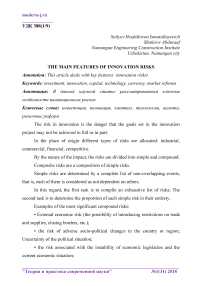The main features of innovation risks
Автор: Soliyev I.I., Shokirov A.
Журнал: Теория и практика современной науки @modern-j
Рубрика: Международные экономические отношения
Статья в выпуске: 1 (31), 2018 года.
Бесплатный доступ
This article deals with key features innovation riskst.
Investment, innovation, capital, technology, currency, market reforms
Короткий адрес: https://sciup.org/140289456
IDR: 140289456
Текст научной статьи The main features of innovation risks
The risk in innovation is the danger that the goals set in the innovation project may not be achieved in full or in part.
In the place of origin different types of risks are allocated: industrial, commercial, financial, competitive.
By the nature of the impact, the risks are divided into simple and compound.
Composite risks are a composition of simple risks.
Simple risks are determined by a complete list of non-overlapping events, that is, each of them is considered as not dependent on others.
In this regard, the first task is to compile an exhaustive list of risks; The second task is to determine the proportion of each simple risk in their entirety.
Examples of the most significant compound risks:
-
• External economic risk (the possibility of introducing restrictions on trade and supplies, closing borders, etc.);
-
• the risk of adverse socio-political changes in the country or region;
Uncertainty of the political situation;
-
• the risk associated with the instability of economic legislation and the current economic situation;
-
• risk of fluctuations in market conditions, prices, exchange rates;
Examples of simple risks as a result:
-
• lack of necessary workers;
-
• Insufficient skills of available employees;
-
• remoteness of technical networks;
-
• late delivery of equipment;
These risks are inherent in any business, regardless of the presence in the entrepreneurial project of an innovative component.1
There are a number of risks encountered exclusively in innovative entrepreneurship:
The risk of originality . It consists in the fact that investing in "breakthrough technologies" is very risky from the point of view of guaranteeing the necessary result, i.е. A really new interesting technology or product.
Risk of information inadequacy . In Russia there are quite a lot of technologies that have been developed for a long time, but interest to them appeared only today. The developers, often quite sincerely, talk about these technologies as existing ones, and even demonstrate the samples obtained 5-10-15 years ago. However, it often turns out that the equipment on which the samples were made has deteriorated over the years, part of the development team has retired, and the technology, alas, is no longer reproducible
Risk of technological inadequacy . There is a fundamental difference between technology as a product of intellectual activity and technology as an object of investment. Technology becomes investment attractive not when it exists, and not even when it can be embodied industrially (which is not always possible to provide), but when it is in demand by the market
Risk of legal inadequacy. The combination of insufficient legal protection of intellectual property with the uncertainty of the rights to develop, especially those created under the Soviet regime, and elementary legal illiteracy often leads to cases where the authors of technology or refuse to disclose some features of their product, thereby discouraging the possibility of investing in it, or They do not comply with their obligations, especially in terms of exclusivity and confidentiality.
Risk of financial inadequacy . It consists in the discrepancy between the content of the investment project and the financial resources necessary for its implementation.
Risk of project unmanageability . As you know, the equally important components necessary for the successful implementation of the investment project is the originality and thoroughness of the project itself, the team's qualification and cohesion, which the project will implement. In Russia, and not only these components are in some contradiction with each other, since the professional qualities necessary for developing the original technology and its industrial implementation are very different. A scientific leader who led his team to develop a unique technology may well be untenable as a leader and the project ends with nothing.
Risk of uncontrollability by business . It consists in the possible difference between the ultimate goals of the investor and the management of the enterprise implementing the project. The investor wants, as a rule, or tomorrow, but a lot, or not very much, but every day, i.e. Pursues strategic goals. Unfortunately, the management of the enterprise has much shorter breathing, it wants at least something, but today. And the investor needs a fairly serious effort to implement its strategy in the enterprise. And given the Russian legislation, especially Russian practice, when the actual owner of the enterprise is its director, and not the owner, these difficulties rarely become surmountable.
Source used:
-
1. Innovative management / Ed. S.I. Ilyenkovoy - M .: Unity, 2001.
-
2. Innovative management / Ed. LNOgolovoy - Moscow: Infra-M, 2001.
-
3. Kokurin D.I. Innovative activity. - M .: Examination, 2001.
-
4. Kruglova N. Yu. Innovative management / Under the scientific. Ed. DS Lvov. - Moscow: Step, 1996
-
5. Солиев И. И. Основные направления государственной поддержки инновационных процессов в сфере связи и информатизации Узбекистана //Молодой ученый. – 2014. – №. 3. – С. 548-549.
Список литературы The main features of innovation risks
- Innovative management / Ed. S.I. Ilyenkovoy - M.: Unity, 2001.
- Innovative management / Ed. LNOgolovoy - Moscow: Infra-M, 2001.
- Kokurin D.I. Innovative activity. - M.: Examination, 2001.
- Kruglova N. Yu. Innovative management / Under the scientific. Ed. DS Lvov. - Moscow: Step, 1996
- Солиев И. И. Основные направления государственной поддержки инновационных процессов в сфере связи и информатизации Узбекистана //Молодой ученый. - 2014. - №. 3. - С. 548-549.


